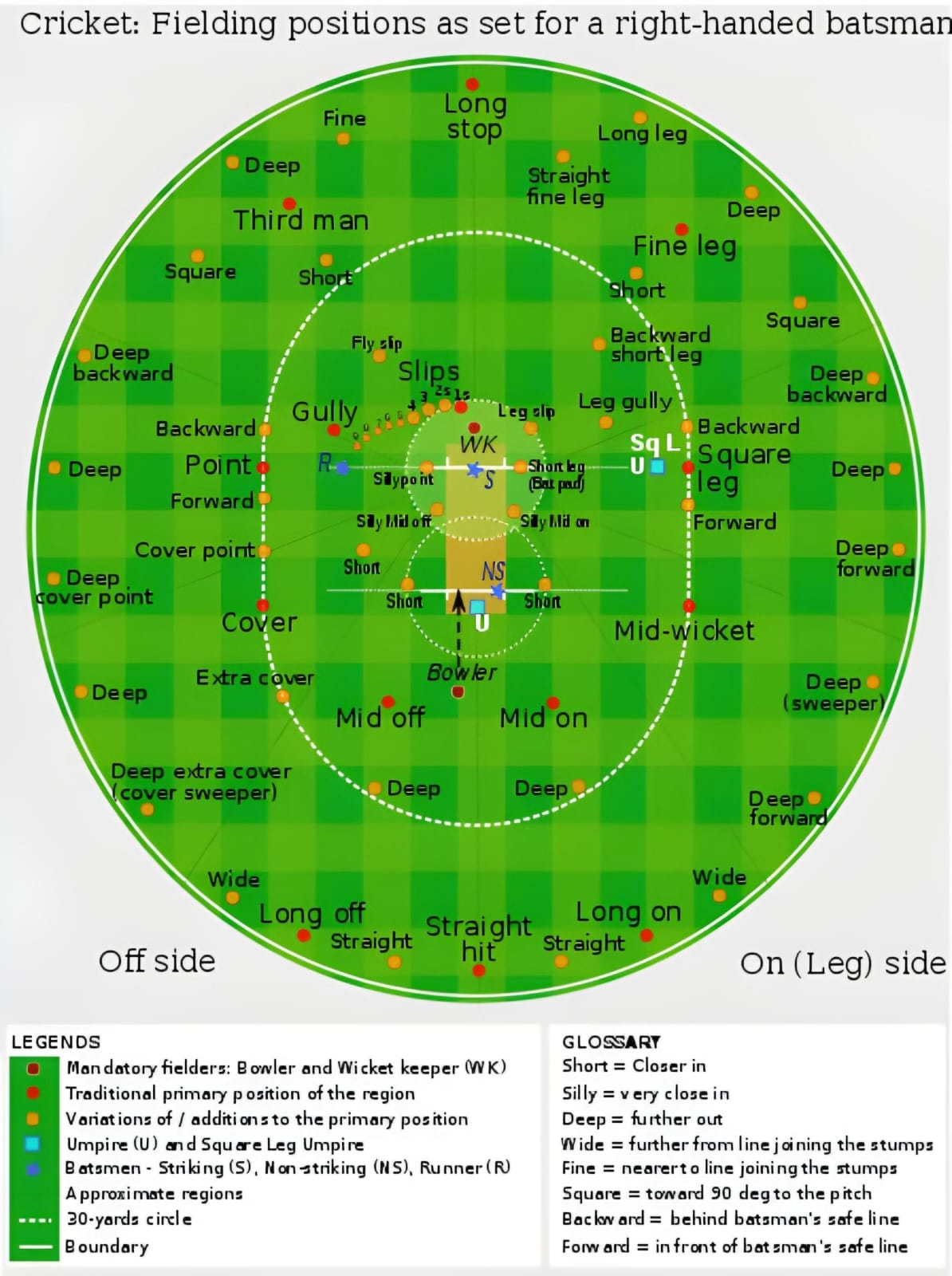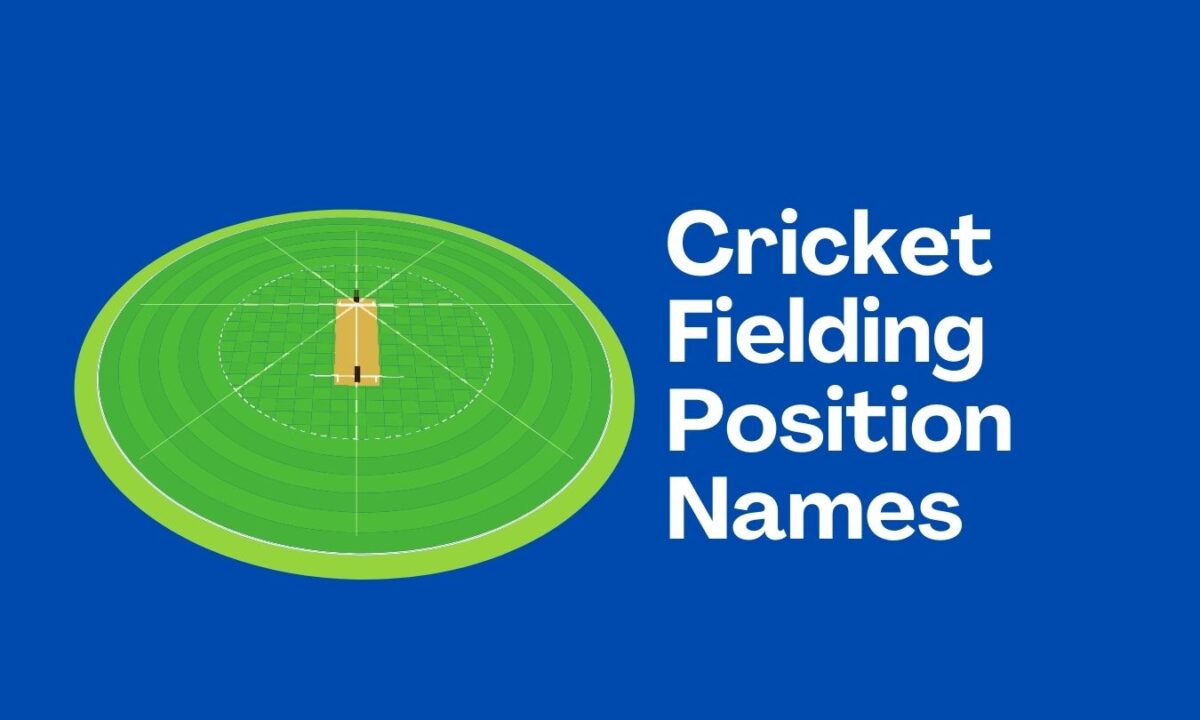Cricket is a game of strategy, and understanding fielding positions is crucial to executing a well-rounded game plan. Let’s dive into the world of cricket fielding positions, using a blend of polar coordinates and descriptive terms to visualize each location.

- Wicket Keeper: The guardian of the stumps, poised to catch, stump, or throw.
- First Slip: A close catcher, in line with the batsman’s leg side.
- Second slip: Another close catcher, extending the slip cordon.
- Third Slip: A third close catcher, continuing the slip cordon line.
- Fly Slip: A deeper version of the traditional slip positions.
- Long Stop: Positioned behind the wicket keeper, acting as a last line of defense.
- Third man: A boundary-side position, between the slip cordon and the wicket keeper.
- Gully: An acute angle from the batsman, between point and the slip cordon.
- Deep Gully: A deeper version of the gully position, closer to the boundary.
- Silly Point: Extremely close to the batsman, daring them to hit it.
- Point: Square to the batsman, on the off side, between cover and gully.
- Deep Point: A boundary-side version of the point position.
- Cover Sweeper: Protecting the cover region, on the off side, near the boundary.
- Cover Point: In line with the popping crease, between extra cover and point.
- Extra Cover: An off-side position, forward of cover point and close to the pitch.
- Deep Extra Cover: A boundary-side version of the extra cover position.
- Silly Mid Off: Extremely close to the batsman, on the off side, tempting risky shots.
- Mid Off: Square to the batsman, on the off side, near the bowler’s end.
- Long Off: Close to the boundary, on the off side, in line with the bowler’s end.
- Straight Hit: A position aligned with the straight boundary, between long-on and long-off.
- Silly Mid On: Dangerously close to the batsman, on the leg side, inviting daring shots.
- Mid On: Square to the batsman, on the leg side, near the bowler’s end.
- Long On: Close to the boundary, on the leg side, in line with the bowler’s end.
- Forward Short Leg: Close to the batsman, forward of square leg, on the leg side.
- Short Mid Wicket: A position between mid-on and square leg, closer to the pitch.
- Mid Wicket: Square to the batsman, on the leg side, near the bowler’s end.
- Deep Mid Wicket: A boundary-side version of the mid-wicket position.
- Sweeper: Covering the area behind square leg, on the leg side, near the boundary.
- Short Square Leg: Close to the batsman, backward of square leg, on the leg side.
- Square Leg: Square to the batsman, on the leg side, between short square leg and deep square leg.
- Deep Square Leg: Close to the boundary, on the leg side, in line with the batsman’s popping crease.
- Leg Gully: A position between the batsman’s leg side and the wicket keeper.
- Long Leg: Close to the boundary, on the leg side, behind square.
- Leg Slip: An unusual position, close to the wicket keeper, on the leg side.
- Short Fine Leg: Close to the batsman, forward of square leg, on the leg side.
- Deep Fine Leg: Close to the boundary, on the leg side, in line with the popping crease.

Cricket Fielding Positions:
There are two main things to consider when discussing fielding positions in cricket:
- Batsman Handedness: The field will be positioned slightly differently depending on whether the batsman is right-handed or left-handed. This is because the batsman’s natural shot direction is different for each side.
- Right-handed batsman: Fielders will be skewed more towards the off-side (bowler’s right) to catch shots played there.
- Left-handed batsman: Fielders will be skewed more towards the leg-side (bowler’s left) to catch shots played there.
- Game Situation: The captain will set the field based on the bowler, batsman, pitch conditions, and the score. This means the positions are constantly changing throughout an innings.
Here’s a breakdown of some common fielding positions:
- Off-side: Wicket-keeper, Slips (1st, 2nd, 3rd, etc.), Gully, Point, Deep Point, Cover, Deep Cover, Mid-off, Long-off.
- Leg-side: Mid-on, Mid-wicket, Square-leg, Fine leg, Third man, Long-on.
- Behind the bowler: Long-stop
- Variations: Silly point, Silly mid-on, Short leg, Backward square leg, Extra cover (midway between cover and mid-off), Leg gully, Sweeper (cover or deep cover), Third man boundary, Ring field (close-in fielders for spin bowling).
How many fielding positions are there?
There are 36 positions. However, due to the dynamic nature of fielding and variations in descriptions, it’s difficult to have a fixed number. The list above provides a comprehensive overview, but captains can always place fielders in non-standard positions based on strategy.
Understanding Specific Positions:
- Mid-on and Mid-off: These fielders are positioned on either side of the pitch, roughly equidistant from the batsman and the wicket. They cover straight drives and lofted shots. Mid-on is on the leg side (bowler’s left) mirroring mid-off on the off-side (bowler’s right).
- Silly point: A highly specialized close-in fielder positioned even closer to the batsman than the short leg, specifically for catching nicks or edges.
- Third man: Positioned on the leg side behind the fine leg, the third man fielder cuts off anything turning away from the batsman to the boundary. The name’s origin is unclear, but theories suggest it might come from a position used in early cricket or a reference to a batsman stationed at third position.
- Cow corner: This refers to the long-on and fine leg region behind the square leg on the leg side. It gets its name because this area is traditionally where the ball goes if a batsman hits a powerful shot over the bowler’s head.
Fielding Rules and Strategies:
- Fielding rules are quite extensive, but some key points include: only nine fielders can be outside the 30-yard circle at any time, fielders can’t change positions while the bowler is running in to bowl, and certain restrictions apply to fielding positions in the powerplay overs.
- There’s no set “formula” for fielding. It’s a strategic process where the captain uses their knowledge of the batsman, bowler, pitch conditions, and the score to place fielders in the most advantageous positions to dismiss the batsman or restrict runs.
- Learning fielding positions can be done through watching professional cricket, studying diagrams, and practicing with others. There are also online resources and coaching available.
- Point fielding refers to a fielder positioned behind the gully on the off-side, specifically to cover drives through that region.
Number of Fielders:
- A maximum of 9 fielders can be positioned outside the 30-yard circle at any given time.
- There’s no restriction on the number of fielders on the leg side, but generally captains will have more fielders on the side where the batsman is naturally more likely to hit the ball (off-side for right-handed batsman, leg-side for left-handed batsman). However, having six fielders all bunched on the leg side wouldn’t be an effective strategy. Field spread is important to cover the entire ground and prevent boundaries.
Improving Fielding:
There are many ways to improve your fielding:
- Practice: Regularly practicing catching, throwing, footwork, and diving techniques is crucial.
- Footwork: Develop agility and quick reflexes to move swiftly to the ball.
- Throwing: Focus on accuracy and power to return the ball quickly and effectively.
- Anticipation: Learn to read the batsman and bowler to anticipate where the
Fielding Runs:
- Fielding runs are penalty runs awarded to the batting team due to fielding errors or a fielder’s deliberate obstruction of the ball. Examples include:
- Overthrows: When a fielder throws the ball past the wicketkeeper and it goes to the boundary.
- Misfields: When a fielder fails to stop the ball cleanly, allowing the batsmen to take extra runs.
- Boundary stops: When a fielder prevents a certain boundary by deliberately stopping or deflecting the ball over the ropes. (This awards four runs instead of six)
Cricket Fielding Drills:
Here are some drills to improve your fielding:
- Catching: Practice catching tennis balls or soft throws from a partner, gradually increasing speed and difficulty.
- Throwing: Set up targets or partners at different distances and practice throwing accurately and powerfully.
- Ground fielding: Practice running laterally, picking up the ball cleanly, and throwing in one smooth motion.
- Diving: Practice diving techniques to stop balls that are just out of reach.
Additional Fielding Tips:
- Communication: Communicate with your fellow fielders to avoid confusion about who’s fielding which area.
- Fitness: Maintain good physical fitness to have the stamina and agility required for effective fielding.
- Concentration: Stay focused throughout the game, anticipate the play, and react quickly.
By understanding fielding positions, strategies, and practicing the necessary skills, you can become a valuable asset to your cricket team.
With this vivid portrayal of cricket’s fielding positions, it becomes clear how each player’s strategic placement contributes to the team’s overall success. Keep these positions in mind the next time you watch a game and enjoy the intricate dance of cricket like never before.
James Paul is a former first-class cricketer and passionate cricket analyst. His decades of experience on the field and his love for the game shape his insights into the strategies and personalities that define world-class cricket.
